
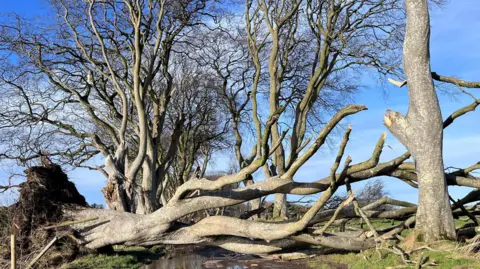 BBC
BBC
Several trees made famous by the fantasy drama Game of Thrones have fallen down
The clear-up operation is continuing after Storm Éowyn caused chaos across Northern Ireland on Friday.
It brought winds of more than 90mph and, at the peak, left 30% of homes and businesses without power.
About 185,000 properties are still without electricity.
Northern Ireland Electricity (NIE) Networks say some residents will be without power for up to 10 days.

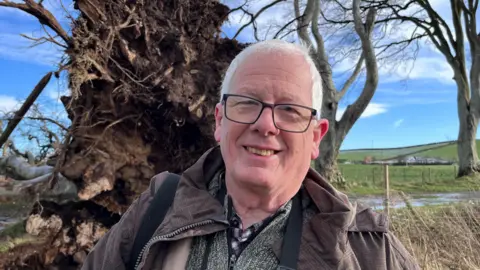
Bob McCallion, from Save the Dark Hedges, says another tree that was damaged might have to be cut down
Four trees at the Northern Ireland beauty spot made famous by the fantasy drama Game of Thrones have fallen down.
Bob McCallion, from Save the Dark Hedges, said another tree that was damaged might have to be cut down.
"I could have predicted this because the wind direction is the same as Storm Isha," he told BBC News NI.
"This happens quite regularly," he said.

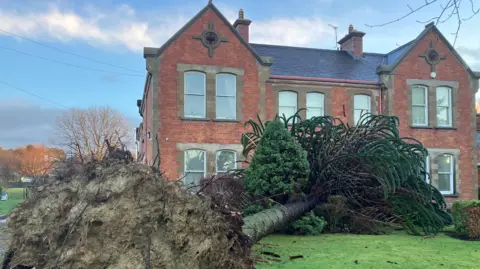
A large tree came down outside the Parochial House at St Patrick's church in Pennyburn
Northern Ireland saw the highest gust in 27 years, with 92.2mph (148km/h) recorded at Killowen in County Down on Friday.
The rare red weather warning, which came in on Friday morning, ended at 14:00 GMT.
A major clean up is under way in the north west after a large tree came down outside the Parochial House at St Patrick's church in Pennyburn.
The church authorities had taken the precaution of having a number of other trees, which were a potential danger, trimmed down previously.
Services at the chapel are unaffected.

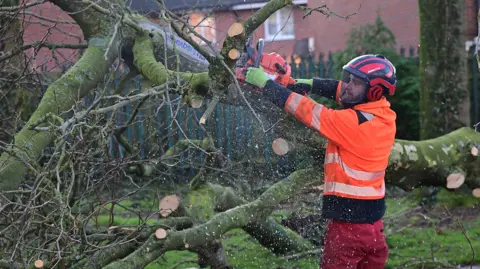 Pacemaker
Pacemaker
Tree surgeons are working on clearing roads on Saturday
In a statement, the Department for Infrastructure said: "There were over 2,300 reported obstructions on the road network during the storm including hundreds on motorways."
"Hazards remain on many roads across the north while the clearance operation continues."
Minister John O'Dowd said: "The work involved in opening just one road can take many hours. For example, 70 trees had to be cleared yesterday to re-open the M2."

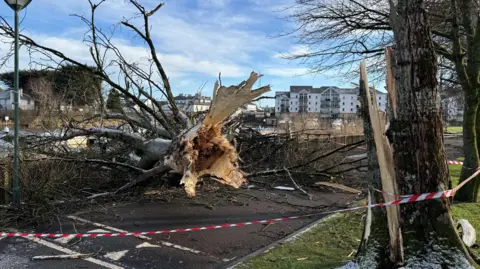
A large tree fell at the Round O jetty, Enniskillen, narrowly missing boats moored nearby
Power outages

 Louise McKillion
Louise McKillion
Louise McKillion and her five children have had to seek shelter in a youth hostel
The power went out in Louise McKillion's Castlewellan home at about 4am on Friday morning.
She told BBC News NI that the family of five, which includes a 17-month-old baby and a child with autism, has had to seek shelter in a nearby youth hostel.
"It's really difficult," she said. "The kids are supposed to go to school on Monday, but I have no uniforms washed. I'll have to ask the school if they can wear their normal clothes."
Ms McMcKillion said she has been told it could be "a few days longer, or up to ten days" until power is restored to her home.
"Nobody can shower, and nobody can have a hot meal—it's terrible," she said.
"You don't realise the impact that has until you're actually put into it and see how much you need electricity and heat."
In County Fermanagh, thousands of properties remain without power.
Many buildings suffered damage including the former tourist office in the centre of Enniskillen.
A large tree fell at the Round O jetty, in Enniskillen, narrowly missing boats moored nearby.
Along with further wind warnings until midnight on Friday, a snow and ice warning was issued across Northern Ireland from 19:00 on Friday until 10:00 on Saturday.
Before the storm hit, the Met Office said there was a danger to life and political leaders urged people to stay at home.

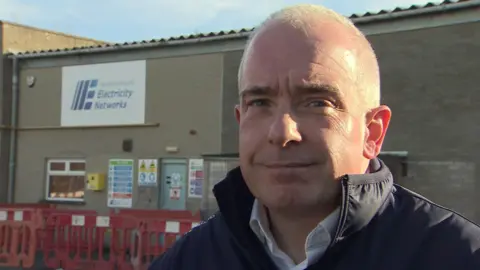
Derek Hynes, from NIE, says they've "issued requests across Europe and into GB" for support
The managing director of NIE Networks said Storm Éowyn caused "devastating levels of damage" to the electricity network in Northern Ireland.
"We've never seen anything like that," Derek Hynes told BBC News NI.
He said the NIE has "issued requests across Europe and into GB," and to the UK government for support.
"We're hoping over the next few days that we will see people pouring onto the island through Belfast, through Dublin, to come here and support us," he said.
"Almost one third of the people here have no power," said Mr Hynes.
He said there are well over 4,000 locations in Northern Ireland where the NIE network has been damaged by the wind or falling trees.
NIE Networks is "prioritising faults" which affect the largest numbers of homes and businesses, but that it's likely that it will take up to 10 days to restore power to all residents.
"We expect the vast majority will have power back by mid next week … but some will still be waiting until next weekend," Mr Hynes said
He said NIE received 20,000 calls in the first 10 hours of the storm on Friday.

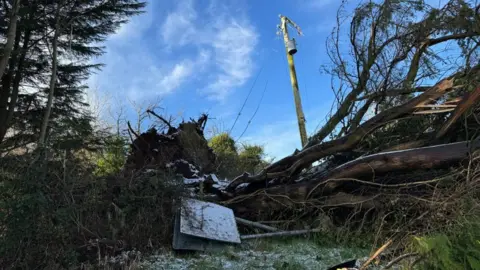
Electricity lines ripped down by fallen trees in Enniskillen, County Fermanagh
In Newtownards, the Craigantlet Road, from the junction of Dunlady Road up to the Cairn Wood Car Park, is closed because of "hazardous conditions that have already resulted in multiple vehicles falling off the road", the PSNI has said.
Several community hubs, operated by councils, are available across Northern Ireland for people who have been impacted by power cuts.
Allow Twitter content?
This article contains content provided by
. We ask for your permission before anything is loaded, as they may be using cookies and other technologies. You may want to read
and
before accepting. To view this content choose
‘accept and continue’.
Public transport

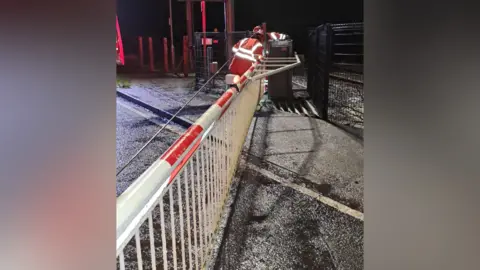 Translink
Translink
Translink said engineers worked overnight to try to restore services
Train services were suspended on Saturday for specialist teams to carry out "safety checks".
Translink has said the first passenger trains will run on the Lisburn, cross border and Bangor lines phasing in during the course of the afternoon.
Clearance work is continuing on the Larne and Londonderry line.
They said: "They will continue working to clear the railway lines and get vital repairs underway."
Metro, Glider and Ulsterbus services returned on Friday with some diversions in place due to ongoing road closures and clearance work in the wake of the storm.
Belfast International Airport said they are "operating a full schedule today," but advised passengers to "check with their airline directly as to the status of their flight in case there is any continuing impact from the storm".
Police are advising the public that some roads across Northern Ireland may remain impassable on Saturday morning, and everyone should take extra care on their journeys.
Fallen trees, power lines and debris may make driving conditions hazardous.

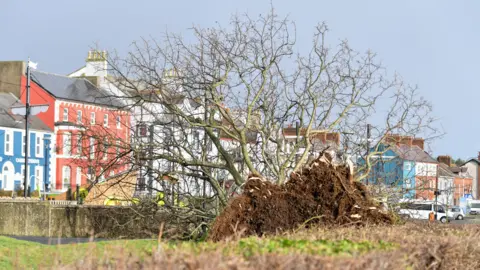 Pacemaker
Pacemaker
Trees were uprooted by the strong winds on Friday
Republic of Ireland
In the Republic of Ireland, where a red warning was also in place, about 460,000 are without power as of 12:15 local time on Saturday, down from a peak of 768,000 earlier on Friday.
A man died after a tree fell on the car he was driving in Raphoe, County Donegal.
A spokesperson for Uisce Éireann said more than 120,000 people are without water and warned that supplies for a further 275,000 people were at risk.
Provisional new records for wind speed were recorded in the Republic Ireland, with hurricane-force sustained winds of 85 mph (137 km/h) at Mace Head, County Galway.

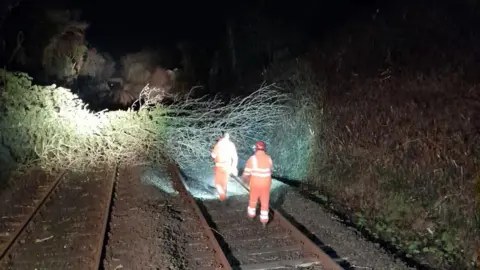 Translink
Translink
Storm Éowyn caused 'extensive damage' to the railway network
Storm Herminia
Meanwhile, further weather warnings have been issued across Northern Ireland ahead of Storm Herminia.
This storm has been named by the Spanish Met Office, with more impacts expected there.
The system is not forecast to be as severe for Northern Ireland as Storm Éowyn.
A yellow weather warning for snow and ice in Northern Ireland will start at 18:00 GMT on Saturday and will last until 10:00 on Sunday.
A yellow wind warning will then be in place from 10:00 GMT to 19:00 on Sunday.
The Met Office is warning of gusts between 40 to 50 mph, with coasts and hills possibly seeing gusts of up to 60 mph.
Those gusts could hamper clean up operations and repairs following Storm Éowyn.
Storm Éowyn is the fifth named storm of the season. It has been caused by powerful jet stream winds pushing low pressure towards the UK and Ireland over the Atlantic Ocean after a recent cold spell over North America.
Red is the most serious weather warning the Met Office can issue, meaning dangerous weather is expected and people are urged to take action to keep themselves and others safe.
It was the first time a red weather warning was issued for Northern Ireland since an impact-based system was introduced in 2011.
Emergency contacts
To report faults or emergencies you should contact:
- Northern Ireland Housing Executive: 03448 920 901
- Openreach: 08000 23 20 23
- Gas networks: 0800 002001
- NI Water: 03457 44 00 88 or visit niwater.com
- Flooding Incident Line: 0300 2000 100
- NIE Networks: 03457 643 643 or visit nienetworks.co.uk
 (1).png)
 1 month ago
14
1 month ago
14


















